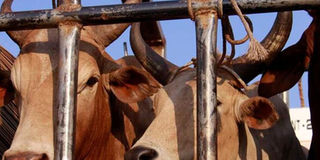Diseases that affect moved cattle

Cattle being transported on a truck. Such animals can suffer from heat stress, shipping fever, and brisket disease. Photo / NMG
What you need to know:
- Control of heat stress is through breeding for heat-tolerant high-producing cows. In case one transports cattle to warmer places, ensure that they live in a cool environment like under a shade or a well-ventilated house.
Many animal owners always ask about the effect of moving cattle from one location to another. In most cases, the cattle are subjected to unnecessary antibiotic injection to prevent presumed negative effects of the movement.
There are conditions that are associated with relocation of cattle from one geographical region to another. These include brisket disease, shipping fever and heat stress.
Brisket disease
The condition is also known as bovine high-mountain disease (BHMD); high altitude disease and big brisket disease. BHMD is characterised by a non-contagious swelling and fluid accumulation in the brisket (chest) region of cattle. Depending on severity, the swelling can extend forward to lower (ventral) neck and jaw and it can also spread backwards to the stomach region. The swelling has the normal body temperature and it is usually painless when touched or pressured. In most places of the world, BHMD occurs in cattle that are reared at high altitudes greater than 5,000ft (1,524m) where the prevalence of the diseases is between 0 and 10 per cent. However, recent findings indicate that altitude is not the only contributing factor as the condition has been found to affect beef animals in heights below 2,000ft.
Clinical signs of BHMD develop slowly over several weeks, making it difficult to associate the condition with location/environmental change.
However, in most cases, it occurs three to four weeks after cattle are moved from lower to higher elevations. In rare conditions, BHMD and death occurs within 24 hours after altitude change.
The main cause of the condition is reduced oxygen, which occurs at high altitudes. Clinical signs of BHMD include laboured breathing, exercise intolerance and death. Aspiration of the fluid produces a straw coloured to clear fluid and this assists in differentiating the condition from injury whereby the swelling is due to blood accumulation (haematoma). At post-mortem, the heart is enlarged, sometimes twice its normal size especially in chronic cases. Treatment of BHMD involves moving animals to lower grounds and the condition can be prevented through selective breeding of animals that are resistant to the condition.
Shipping fever
It is also referred to as transit fever. This affects cattle and is characterised by fever and respiratory distress a week or two after animals have been transported from one area to another especially if they have moved to a colder place.
The disease is common in calves in feedlot systems because they are purchased from diverse locations and congregated in one place.
Up to 50 per cent of the calves can be affected with a death rate of up to 10 per cent. Factors that predispose calves to shipping fever include transportation stress, poor milk replacers, and cold environment/houses.
Cattle of other ages are also vulnerable to the disease. Bacteria that include pasteurella, mycoplasma and mannheimia have been isolated from sick animals.
Viruses too have been incriminated. Control of the disease is through vaccination. The vaccine is produced in the country but it is not cost-effective for a trader who is transporting one animal as it is packaged in multiple doses.
Heat stress
Although all animals suffer from heat stress, dairy cattle are more vulnerable because most of the breeds originated from cold regions. Dairy cattle, therefore, prefer mild temperatures of -5 to 25oC. When the animals are moved to areas with higher temperatures of 28oC and above, they experience heat stress. Signs include respiratory distress with frothing from the mouth in extreme cases. There is also reduced production and fertility. For example, heat stress has been shown to decrease forage intake by 18 per cent and milk yield by 32 per cent at 32oC as compared to 16oC. Abortion in females and infertility in males are other signs that are observed in cases of heat stress.
Apart from the recommended temperature-humidity index (THI) way of assessing the expected level of heat stress in cattle, one can do so by taking rectal temperatures in suspected animals.
Normal temperature is 38.5oC, so a cow that has a temperature of 39oC in the afternoon and it is not sick is likely experiencing heat stress.
Control of heat stress is through breeding for heat-tolerant high-producing cows. In case one transports cattle to warmer places, ensure that they live in a cool environment such as under a shade or a well-ventilated house.
Addition of fans and water sprinkling of the animals plus supply of cool water will assist the animals to adapt to the environment with time.





